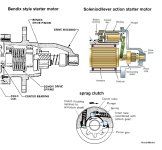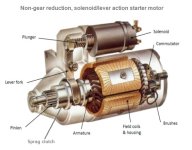My starter bendix drive has a tough time engaging sometimes. Sometimes i get a loud clunk sound, and then the bendix just spins with out engaging. Sometimes it does it just once or twice and then she engages fine. This is has been slowly getting worse for awhile now.
a few questions for you gents , if you don't mind. First of all i'm dealing with a 19' 1990 Blue Water, 4.3 mercruiser , 2 barrel carb.
The previous owner didn't do me any favors by putting a "New Motor" in it prior to selling it to me last spring. Oh it ran great the first time i took her out, and i shelled out the cash......but i've been working on it off and on all summer right into fall getting this thing running decent and safe again. It didn't take me long to figure out this was not a marine engine he put in. No water fuel separator, highly illegal fuel pump, had the wrong carb on it, etc..etc... I slowly went through it and got the the water pump, gimble bearings and new bellows replaced, along with the lower shift cable why i was at it. My wife really likes this old boat, and it's in pretty decent shape. The hull is sound, and when she's running right it has plenty of power with the right prop. i got a lot of boat education this year, and put a lot of elbow grease and labors of love into it....(Besides pulling my hair out now and then...)
So now here we are with the bendix drive going out in the starter. Being a rookie at marine mechanics myself i have no idea if a marine grade starter was even put on this engine, and actually I doubt it with everything else i've had to do to convert this motor to a point the coast guard wouldn't hang me by the yard arm.
I have verified it is a 4.3 motor and had a marine mechanic tell me he thought it was a truck motor due to the amount of power it has, but i need to change out the soft plugs to brass or stainless when i winterize it . For a 3000# glass boat it has plenty of power with a 19 degree prop. But i have to figure out what type of starter to buy for this baby. I have no engine ID numbers that i can find.
What do you think guys, can ya help me out here? Kirk
a few questions for you gents , if you don't mind. First of all i'm dealing with a 19' 1990 Blue Water, 4.3 mercruiser , 2 barrel carb.
The previous owner didn't do me any favors by putting a "New Motor" in it prior to selling it to me last spring. Oh it ran great the first time i took her out, and i shelled out the cash......but i've been working on it off and on all summer right into fall getting this thing running decent and safe again. It didn't take me long to figure out this was not a marine engine he put in. No water fuel separator, highly illegal fuel pump, had the wrong carb on it, etc..etc... I slowly went through it and got the the water pump, gimble bearings and new bellows replaced, along with the lower shift cable why i was at it. My wife really likes this old boat, and it's in pretty decent shape. The hull is sound, and when she's running right it has plenty of power with the right prop. i got a lot of boat education this year, and put a lot of elbow grease and labors of love into it....(Besides pulling my hair out now and then...)
So now here we are with the bendix drive going out in the starter. Being a rookie at marine mechanics myself i have no idea if a marine grade starter was even put on this engine, and actually I doubt it with everything else i've had to do to convert this motor to a point the coast guard wouldn't hang me by the yard arm.
I have verified it is a 4.3 motor and had a marine mechanic tell me he thought it was a truck motor due to the amount of power it has, but i need to change out the soft plugs to brass or stainless when i winterize it . For a 3000# glass boat it has plenty of power with a 19 degree prop. But i have to figure out what type of starter to buy for this baby. I have no engine ID numbers that i can find.
What do you think guys, can ya help me out here? Kirk


 click to enlarge
click to enlarge


